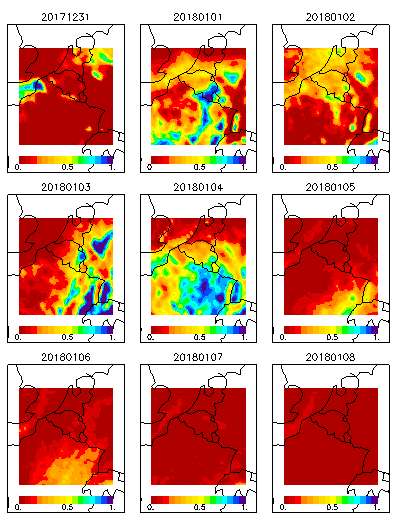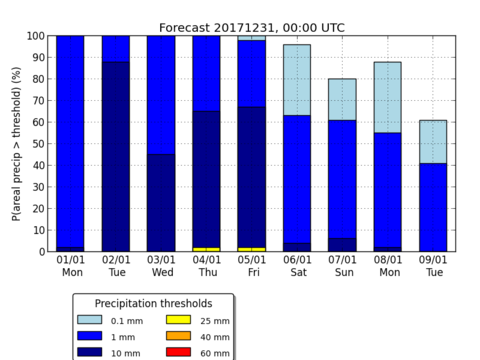Hydrological Ensemble prediction system for the River Meuse and the Scheldt basins (HEPS)
Context and objectives
At the time of writing the first proposal for this project, operational flood warnings systems managed at the regional authorities relied primarily on a efficient observation (rainfall and river discharge) network and on mathematical models forecasting the discharges at the short term. The precipitation forecast of the RMI was used as an additional scenario.
Since 1979, the ECMWF has been issuing operational forecasts at the medium-range. In 1992, the ECMWF Ensemble Prediction System (EPS) became operational: ensemble forecasts are constructed by perturbing the initial atmospheric conditions, and including a stochastic component in the model physics. This gives rise to an ensemble of different possible scenarios, which allows us to associate uncertainties to meteorological forecasts. As these forecasts gained more and more skill, due to the increasing spatial resolution, improvements in the model physics and data assimilation of more observations, the idea arose to investigate the use of EPS predictions as input for hydrological models. This started the study of probabilistic hydrological forecasts and the development of early warnings based on these forecasts.
The research and development activities related to the set-up of the Hydrological Ensemble Prediction System (HEPS) are summarized in the next section, followed by some results.
Methodology
The project started by putting together available the building blocks: the so-called SCHEME hydrological model (see figure below). for the SCHEldt and the MEuse river basins, and the operational and archived EPS, but also meteorological observations from RMI networks - synoptic stations, automatic weather stations, and merged radar and raingauge quantitative precipitation estimates (Goudenhoven and Delobbe, 2009), and discharges at streamflow gauging stations operated by regional administrations. The process can be described as follows:
We run a hydrological simulation, forced by interpolated meteorological observations until this morning (last 24 h precipitation are cumulated from 6:00 UTC yesterday to 6:00 UTC today). We store the state variables of the hydrological model (water content of a set of conceptual stores) as initial conditions for the next step.
Starting from these initial conditions, we run the hydrological model in forecasting mode, with the model forced by the meteorological variables as predicted by the first member of the EPS. This provides us with a first predicted hydrogram for the next 9 days. We repeat this for the other members of the EPS. Since 1996 the EPS ensembles contains 51 members (1 control member and 50 perturbed members), so we end up with 51 hydrograms.
The resulting hydrological ensemble of streamflows can be viewed in a deterministic way – e.g. considering just the ensemble mean – or in a probabilistic way – estimating the probability of exceeding a critical streamflow level, or associating error bands with the ensemble mean.
In order to assess the methodology, archived EPS were used to reprocess the hydrological ensemble predictions for past situations (so-called “hindcasts”). Verification scores for probabilistic forecasts were calculated and revealed that the HEPS has skill and value for sub-basins of the Meuse and Scheldt rivers (Termonia and Roulin, 2004, Roulin and Vannitsem, 2005, Roulin and Demarée, 2007, Roulin, 2007).
The ECMWF EPS used as forcing data are not perfect: they are known to have biases in the ensemble mean and to lack reliability in their probabilistic interpretation. By comparing forecasts of past situations and their corresponding observations, it is possible to calibrate statistical models that can be used to improve the subsequent ensemble predictions. This technique is referred to as post-processing. Post-processing of precipitation ensemble predictions was investigated by Roulin and Vannitsem (2012). Different post-processing techniques were compared for instance by Pelosi et al (2017). During the last ten years, there has been a growing interest in developing post-processing techniques suited for meteorological ensemble predictions as well as for hydrological ensemble predictions. Reviews can be found in Vannitsem et al (2018) and in Boucher et al (2018).
Hydrological ensemble predictions can be also improved by post-processing techniques. In this project, we have chosen to take advantage of the operational reforecast data provided by ECMWF since 2008 and to prepare hydrological reforecasts that can be used to calibrate statistical models. These models are then applied to improve the hydrological ensembles (Roulin and Vannitsem, 2015, Van den Bergh and Roulin, 2016).
In the meanwhile, a pre-operational procedure was developed for the Demer in the Scheldt basin and for the Ourthe in the Meuse basin. Daily reports were issued and proposed to a panel of regional authorities in charge of operational hydrology. These reports contained maps of the probability of high precipitation for the next 9 days and graphs with the probability that the streamflow exceeds a given threshold up to a lead time of 9 days.
The methodology was then extended to the major sub-basins of the Scheldt and the Meuse basins. The skill of the hydrological ensemble predictions was assessed by Van den Bergh and Roulin (2010). The operational procedure was complemented with a streamflow updating module, which takes errors between the simulated and observed streamflows from the past days into account in real time.
Future developments consist of implementing post-processing techniques in the operational procedure, and focusing also on hydrological drought and low flows. Research on post-processing will be pursued, but also research on data assimilation of satellite products like soil moisture (see related activities in H-SAF +link). The forecast range will be extended to 15 days. Research has also been initiated on the feasibility of hydrological seasonal outlooks for Belgium.

Flow chart of the SCHEME model for an individual grid cell. Indicated are the different land cover tiles, the conceptual reservoirs, and the adjustable model parameters in yellow. The output from each grid cell is routed through the river network to the outlet where discharge is modeled.
Results
The following figures are taken from the HEPS in operation on the 31st of December, 2017. It is worth noting that these results were made available only to organizations authorized to issue warnings.
The first figure is a panel with the maps of the probability that the precipitation exceeds 10 mm/24h for the next nine days on an area covering Belgium and upstream parts of the Meuse and Scheldt River basins. The second figure shows an ensemble of possible hydrographs for the Ourthe at Tabreux starting from the daily discharge measured on the issue date, and extending 9 days into the future. The third figure represents the probabilty that the daily precipitation averaged over the Ourthe catchment upstream of Tabreux will exceed various thresholds.

Probability of Precipitation over Belgium from the ECMWF ensemble forecast. Probability of exceeding 10 mm of rainfall. Precipitation cumulated from D 06:00 UTC to D+1 06:00 UTC.

Hydrological Ensemble Forecast: daily discharge for Ourthe at Tabreux.

Daily probability of precipitation for the Ourthe catchment (Tabreux outlet).
Execution
Period: 2003 - present
RMI participants: Joris Van den Bergh (research and development), Emmanuel Roulin (research and development, scientific coordination)
Funding sources:
- 2003-2004 : project Action 1 of the Belgian Science Policy Office (Belspo) “Evaluation et prévisions des risques hydrologiques en Belgique.” (MO/34/009)
- 2005: RMI internal project “Hydrological Ensemble Predictions for the Demer and the Ourthe” (HEPDO).
- 2008 – present : SPPMINMETEO-HEPDO
References
From the team:
Boucher, M.-A., E. Roulin, and V. Fortin, 2018. Short-range ensemble forecast post-processing. In Duan, Q., F. Pappenberger, J. Thielen, A. Wood, H.L. Cloke, and J.C. Schaake Eds., Handbook of hydrometeorological ensemble forecasting, Springer, to appear.
Giot, O., Termonia, P., Degrauwe, D., De Troch, R., Caluwaerts, S., Smet, G., Berckmans, J., Deckmyn, A., De Cruz, L., De Meutter, P., Duerinckx, A., Gerard, L., Hamdi, R., Van den Bergh, J., Van Ginderachter, M., and Van Schaeybroeck, B., 2016. Validation of the ALARO-0 model within the EURO-CORDEX framework, Geosci. Model Dev., 9, 1143-1152, https://doi.org/10.5194/gmd-9-1143-2016.
Pelosi, A., H. Medina, J. Van den Bergh, S. Vannitsem, and G.B. Chirico, 2017: Adaptive Kalman Filtering for Postprocessing Ensemble Numerical Weather Predictions. Mon. Wea. Rev., 145, 4837–4854, https://doi.org/10.1175/MWR-D-17-0084.1
Roulin, E., 2007. Skill and relative economic value of medium-range hydrological ensemble predictions. Hydrology and the Earth System Sciences, 11, 725-737, https://doi.org/10.5194/hess-11-725-2007.
Roulin, E., and G. Demarée, 2007. Onzekerheidsanalyse van overstromingen met behulp van hydrologische ensemble voorspellingen. Water, n°32, 29-34.
Roulin, E., and S. Vannitsem, 2005. Skill of medium-range hydrological ensemble predictions. Journal of Hydrometeorology, 6, 729-744, https://doi.org/10.1175/JHM436.1
Roulin, E., and S. Vannitsem, 2012. Postprocessing of ensemble precipitation predictions with extended logistic regression based on hindcasts. Monthly Weather Review, 2012, 140, 874-888, https://doi.org/10.1175/MWR-D-11-00062.1
Roulin, E., and S. Vannitsem, 2015. Post-processing of medium-range probabilistic hydrological forecasting : impact of forcing, initial conditions and model errors. Hydrological Processes, 29, 1434-1449 (doi:10.1002/hyp.10259).
Termonia, P., en E. Roulin, 2004. Numerieke modellering ten behoeve van neerslagvoorspellingen en hydrologische toepassingen. Wetenschappelijke en technische publicatie n°035, Koninklijk Meteorologisch Instituut van België, Brussel, 15 pp.
Van den Bergh, J., and E. Roulin, 2010. Hydrological ensemble prediction and verification for the Meuse and Scheldt basins. Atmospheric Science Letters, 11, 64-71, doi:10.1002/asl.250.
Van den Bergh, J. and Roulin, E., 2016. Postprocessing of Medium Range Hydrological Ensemble Forecasts Making Use of Reforecasts. Hydrology 2016, 3(2), 21; doi:10.3390/hydrology3020021.
Other
Goudenhoofdt E. and L. Delobbe, 2009. Evaluation of radar-gauge merging methods for quantitative precipitation estimates. Hydrol. Earth Syst. Sci., 13, 195-203, https://doi.org/10.5194/hess-13-195-2009
Vannitsem, S., D. S. Wilks, and J.W. Meßner Eds., 2018. Statistical Postprocessing of Ensemble Forecasts, Elsevier, to appear.
